Connect With Us
Blog
Items filtered by date: July 2025
Corns and Calluses Can Cause Discomfort in the Feet
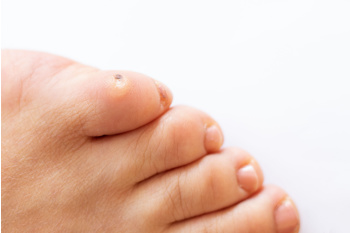
Corns and calluses are thickened areas of skin that develop as a natural response to repeated pressure or friction. Although they help protect the skin, they can become painful, especially when located on weight-bearing areas of the feet. Corns typically form on the tops or sides of toes and are often small and round. Calluses are usually larger and develop on the soles of the feet, especially under the heels or balls of the feet. Wearing tight shoes, walking barefoot, or having foot deformities like bunions can contribute to the formation of corns and calluses. While these skin changes are not harmful on their own, the discomfort they cause may affect walking and daily comfort. Treatment often includes reducing pressure through padding, wearing properly fitted footwear, and sometimes using custom orthotics. If corns or calluses are causing pain, it is suggested you visit a podiatrist for proper care.
Corns can make walking very painful and should be treated immediately. If you have questions regarding your feet and ankles, contact Robert Hutchison, DPM, FACFAS of Lower Keys Foot & Ankle Surgery. Our doctor will treat your foot and ankle needs.
Corns: What Are They? And How Do You Get Rid of Them?
Corns are thickened areas on the skin that can become painful. They are caused by excessive pressure and friction on the skin. Corns press into the deeper layers of the skin and are usually round in shape.
Ways to Prevent Corns
There are many ways to get rid of painful corns such as:
- Wearing properly fitting shoes that have been measured by a professional
- Wearing shoes that are not sharply pointed or have high heels
- Wearing only shoes that offer support
Treating Corns
Although most corns slowly disappear when the friction or pressure stops, this isn’t always the case. Consult with your podiatrist to determine the best treatment option for your case of corns.
If you have any questions please feel free to contact our office located in Key West, FL . We offer the newest diagnostic and treatment technologies for all your foot and ankle needs.
Understanding Ingrown Toenails in Children
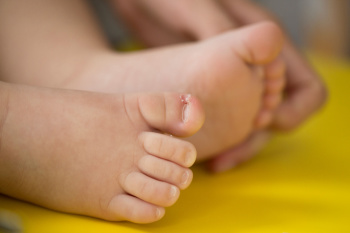
An ingrown toenail occurs when the edge of the nail grows into the surrounding skin, causing irritation and discomfort. In children, this can be caused by improper nail trimming, wearing tight shoes, injuries, or inherited nail shapes. Symptoms include redness, swelling, pain along the nail edge, and sometimes drainage if an infection develops. Children may avoid walking or show signs of discomfort during activity. A podiatrist can gently lift or remove the ingrown portion, treat any infection, and provide guidance to prevent recurrence. Early care is important to avoid worsening symptoms. If your child is showing signs of an ingrown toenail, it is suggested that you schedule an appointment with a podiatrist to ensure safe, effective treatment and lasting relief.
Making sure that your children maintain good foot health is very important as they grow. If you have any questions, contact Robert Hutchison, DPM, FACFAS of Lower Keys Foot & Ankle Surgery. Our doctor can provide the care you need to keep you pain-free and on your feet.
Keeping Children's Feet Healthy
Having healthy feet during childhood can help prevent medical problems later in life, namely in the back and legs. As children grow, their feet require different types of care. Here are some things to consider...
Although babies do not walk yet, it is still very important to take care of their feet.
Avoid putting tight shoes or socks on his or her feet.
Allow the baby to stretch and kick his or her feet to feel comfortable.
As a toddler, kids are now on the move and begin to develop differently. At this age, toddlers are getting a feel for walking, so don’t be alarmed if your toddler is unsteady or ‘walks funny’.
As your child gets older, it is important to teach them how to take care of their feet.
Show them proper hygiene to prevent infections such as fungus.
Be watchful for any pain or injury.
Have all injuries checked by a doctor as soon as possible.
Comfortable, protective shoes should always be worn, especially at play.
If you have any questions please feel free to contact our office located in Key West, FL . We offer the newest diagnostic and treatment technologies for all your foot and ankle needs.
Sever's Disease in Growing Children
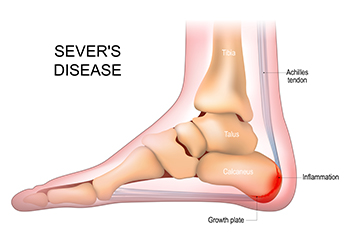
Sever's disease, also known as calcaneal apophysitis, is a common cause of heel pain in growing children. It occurs when the growth plate in the heel becomes inflamed due to repetitive stress or pressure. This condition often affects active children between 8 and 14 years old who are involved in sports that include running or jumping. Risk factors include rapid growth, flat feet, poor footwear, and intense physical activity. Symptoms may include heel pain, limping, stiffness, and tenderness in the back of the foot. A podiatrist can diagnose Sever's disease through a physical exam and recommend treatments, such as rest, stretching, proper footwear, and custom inserts. If your active child has heel pain, it is suggested that you visit a podiatrist for an accurate diagnosis and treatment plan.
Sever's disease often occurs in children and teens. If your child is experiencing foot or ankle pain, see Robert Hutchison, DPM, FACFAS from Lower Keys Foot & Ankle Surgery. Our doctor can treat your child’s foot and ankle needs.
Sever’s Disease
Sever’s disease is also known as calcaneal apophysitis, which is a medical condition that causes heel pain I none or both feet. The disease is known to affect children between the ages of 8 and 14.
Sever’s disease occurs when part of the child’s heel known as the growth plate (calcaneal epiphysis) is attached to the Achilles tendon. This area can suffer injury when the muscles and tendons of the growing foot do not keep pace with bone growth. Therefore, the constant pain which one experiences at the back of the heel will make the child unable to put any weight on the heel. The child is then forced to walk on their toes.
Symptoms
Acute pain – Pain associated with Sever’s disease is usually felt in the heel when the child engages in physical activity such as walking, jumping and or running.
Highly active – Children who are very active are among the most susceptible in experiencing Sever’s disease, because of the stress and tension placed on their feet.
If you have any questions, please feel free to contact our office located in Key West, FL . We offer the newest diagnostic and treatment technologies for all your foot and ankle injuries.
Gout Pain Can Be Managed
Recognizing Metatarsal Stress Fractures
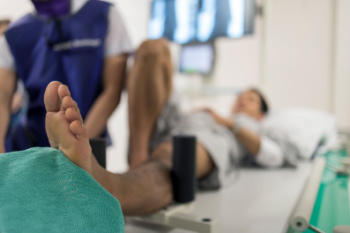
A metatarsal stress fracture is a small crack in one of the long bones of the foot, caused by repetitive pressure or overuse. Common in athletes, dancers, and individuals who increase activity levels quickly, this injury often develops gradually. Symptoms include localized pain that worsens with weight-bearing, swelling, and tenderness over the affected bone. Risk factors include poor footwear, sudden changes in activity or intensity, weak bones, and biomechanical issues. A podiatrist can diagnose the fracture using imaging and physical exams and will guide recovery through rest, protective footwear, or activity modification. If you have foot pain that increases with movement, it is suggested that you promptly visit a podiatrist who can accurately diagnose the problem and provide treatment..
Stress fractures occur when there is a tiny crack within a bone. To learn more, contact Robert Hutchison, DPM, FACFAS from Lower Keys Foot & Ankle Surgery. Our doctor can provide the care you need to keep you pain free and on your feet.
How Are They Caused?
Stress fractures are the result of repetitive force being placed on the bone. Since the lower leg and feet often carry most of the body’s weight, stress fractures are likely to occur in these areas. If you rush into a new exercise, you are more likely to develop a stress fracture since you are starting too much, too soon. Pain resulting from stress fractures may go unnoticed at first, however it may start to worsen over time.
Risk Factors
- Gender – They are more commonly found in women compared to men.
- Foot Problems – People with unusual arches in their feet are more likely to develop stress fractures.
- Certain Sports – Dancers, gymnasts, tennis players, runners, and basketball players are more likely to develop stress fractures.
- Lack of Nutrients – A lack of vitamin D and calcium may weaken the bones and make you more prone to stress fractures
- Weak Bones – Osteoporosis can weaken the bones therefore resulting in stress fractures
Stress fractures do not always heal properly, so it is important that you seek help from a podiatrist if you suspect you may have one. Ignoring your stress fracture may cause it to worsen, and you may develop chronic pain as well as additional fractures.
If you have any questions, please feel free to contact our office located in Key West, FL . We offer the newest diagnostic and treatment technologies for all your foot care needs.
Common Causes of Toe Pain
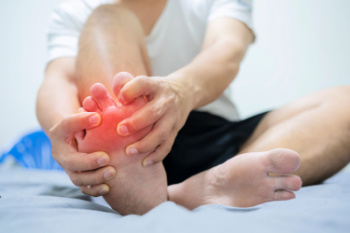
Toe pain can stem from a variety of everyday causes. Stubbing the toe may lead to bruising or even fractures, while wearing tight or narrow shoes can cause pressure, irritation, and alignment problems. As people age, joints in the toes may stiffen or develop arthritis, leading to chronic discomfort. Persistent toe pain should not be ignored, especially if it interferes with walking or daily activities. A podiatrist can diagnose the source of the pain, offer treatments to relieve discomfort, and suggest footwear or custom supports to prevent future issues. If you are experiencing toe pain, it is suggested that you schedule a visit with a podiatrist to restore comfort and maintain your foot health.
Toe pain can disrupt your daily activities. If you have any concerns, contact Robert Hutchison, DPM, FACFAS of Lower Keys Foot & Ankle Surgery. Our doctor can provide the care you need to keep you pain-free and on your feet.
What Causes Toe Pain?
Most severe toe pain is caused due to a sports injury, trauma from dropping something heavy on the toe, or bumping into something rigid. Other problems can develop over time for various reasons.
Toe pain can be caused by one or more ailments. The most common include:
- Trauma
- Sports injury
- Wearing shoes that are too tight
- Arthritis
- Gout
- Corns and calluses
- Hammertoe
- Bunions
- Blisters
- Ingrown toenails
- Sprains
- Fractures (broken bones)
- Dislocations
When to See a Podiatrist
- Severe pain
- Persistent pain that lasts more than a week
- Signs of infection
- Continued swelling
- Pain that prevents walking
Diagnosis
In many cases the cause of toe pain is obvious, but in others, a podiatrist may want to use more advanced methods to determine the problem. These can range from simple visual inspections and sensation tests to X-rays and MRI scans. Prior medical history, family medical history, and any recent physical traumatic events will all be taken into consideration for a proper diagnosis.
Treatment
Treatments for toe pain and injuries vary and may include shoe inserts, padding, taping, medicines, injections, and in some cases, surgery. If you believe that you have broken a toe, please see a podiatrist as soon as possible.
If you have any questions please feel free to contact our office located in Key West, FL . We offer the newest diagnostic tools and technology to treat your foot and ankle needs.

